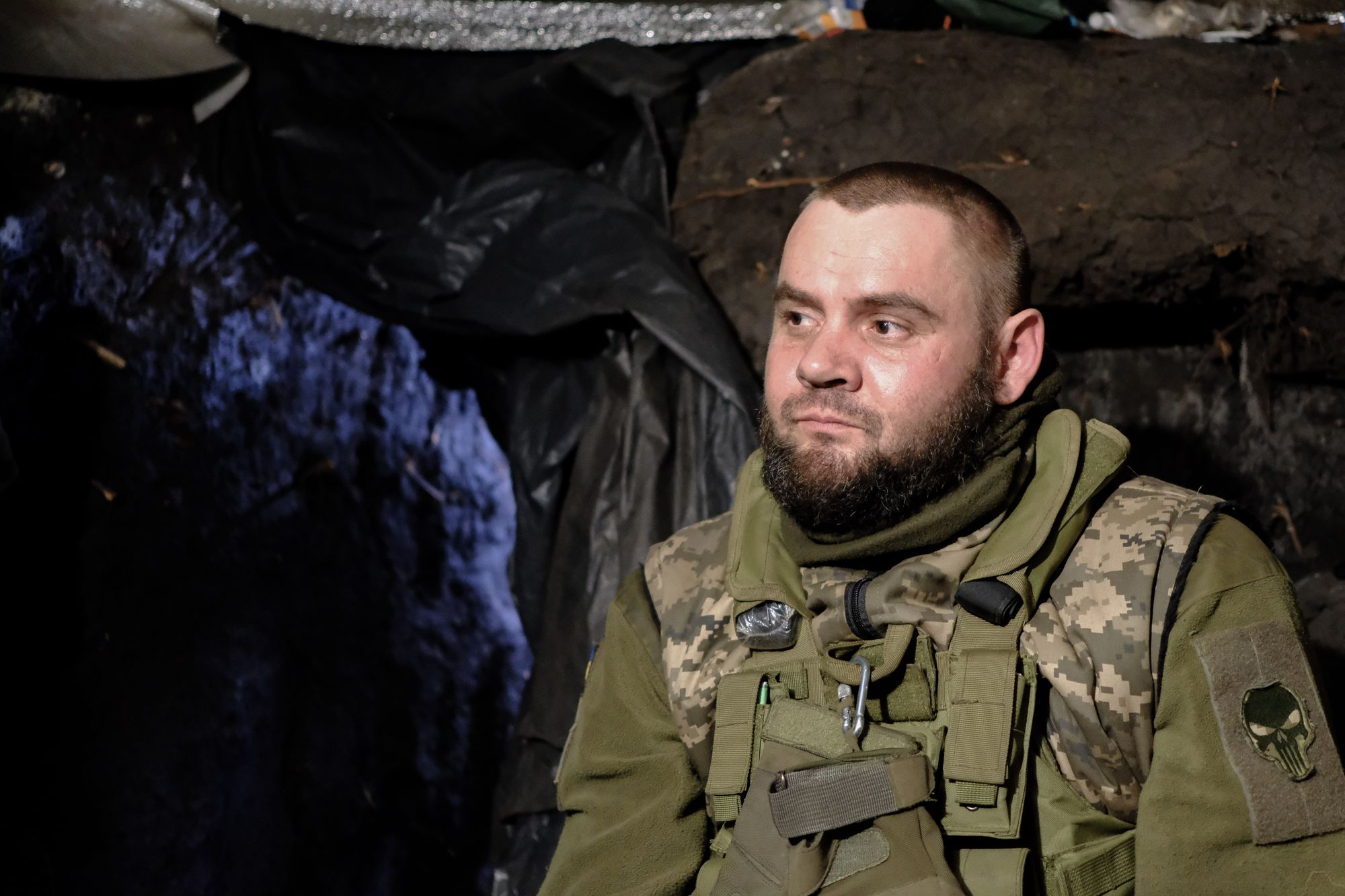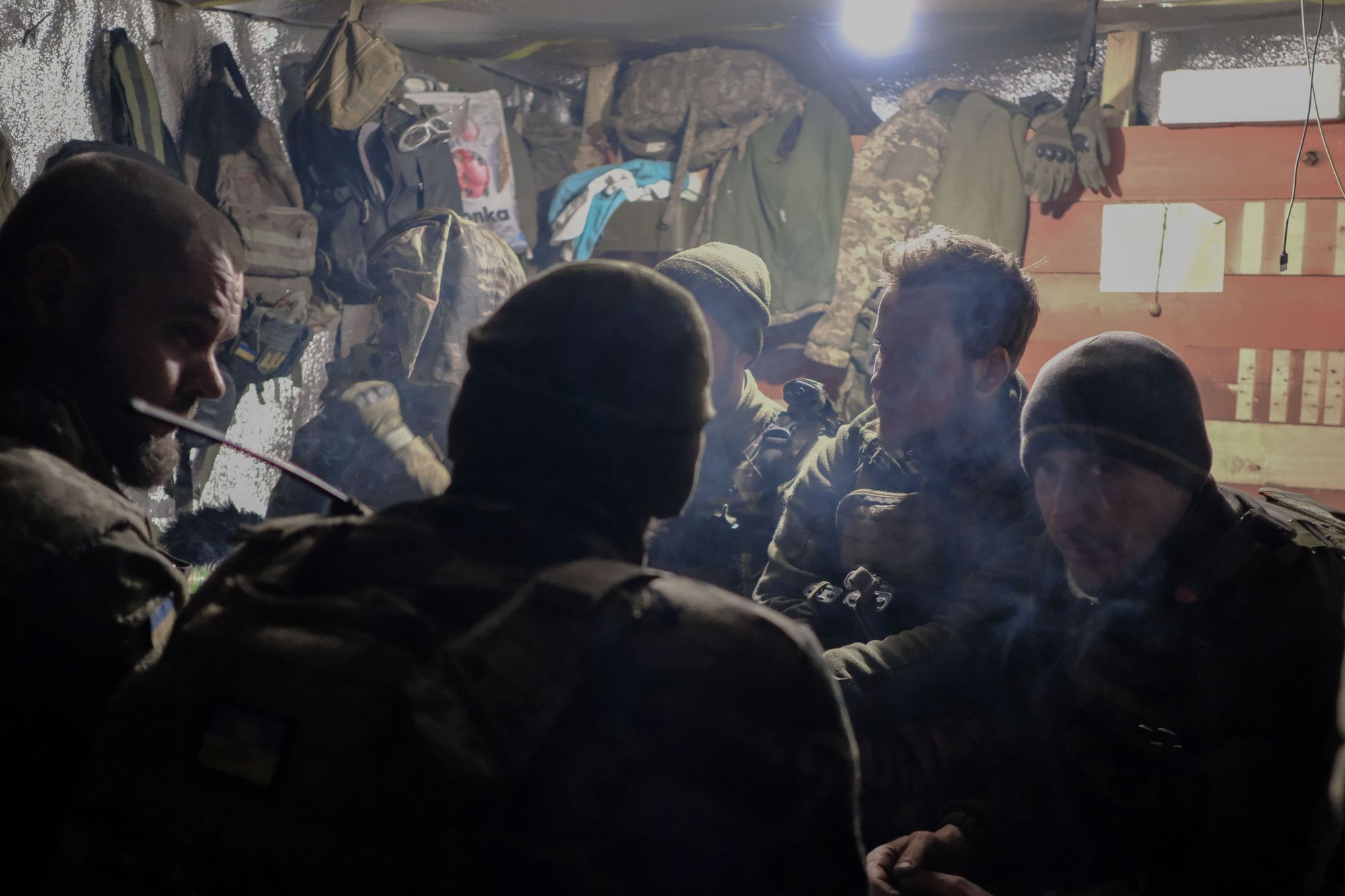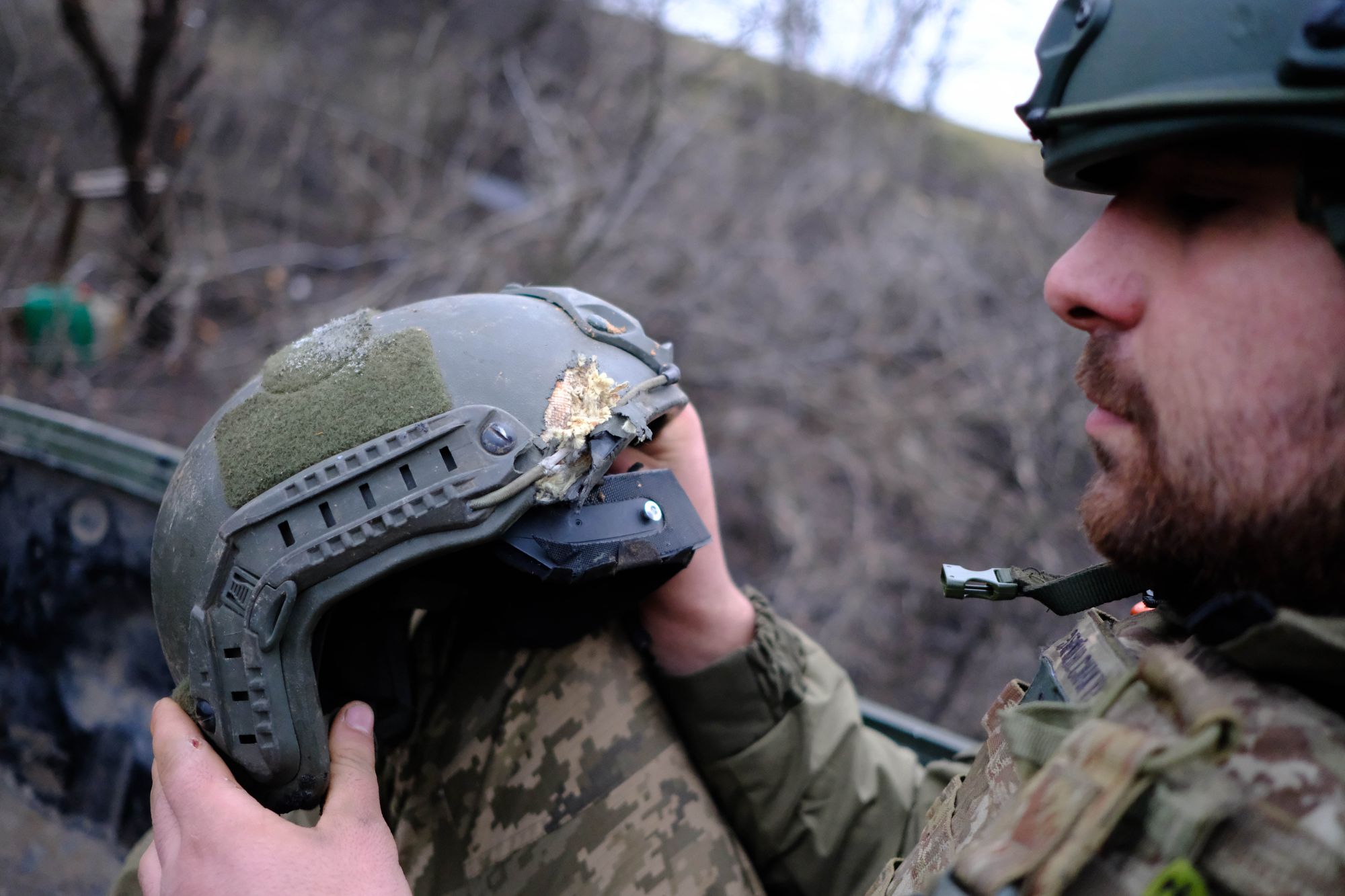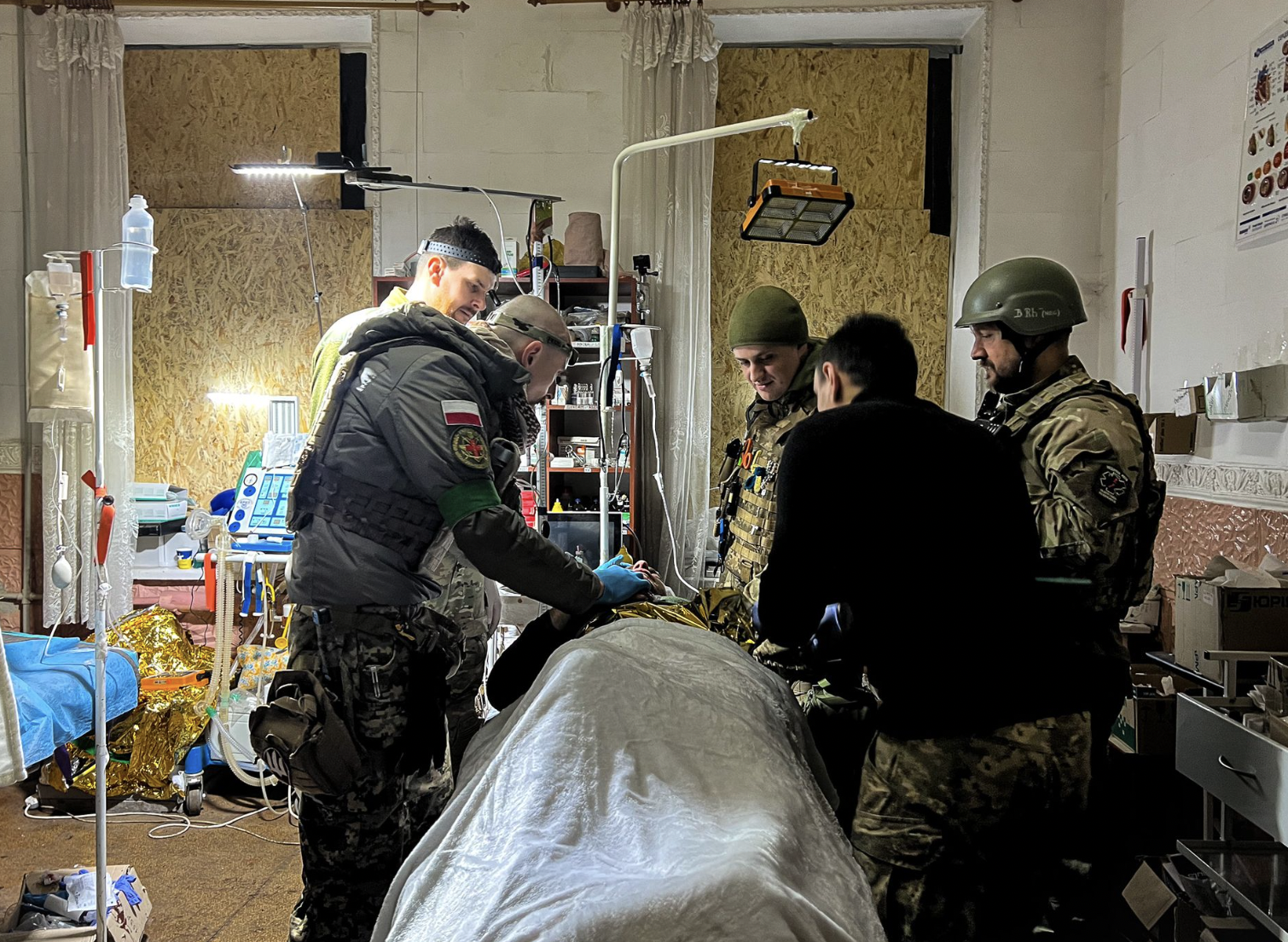
DONETSK OBLAST – Climbing to a firing position through trenches dug into black Ukrainian soil, the relative quiet in the air is only reassuring to an extent.
At the most forward point, a Soviet-era recoilless rifle stands watch, dug into a shallow depression in the ground.
Bohdan, a company commander of Ukraine’s 10th Mountain Assault Brigade, rests casually in the dirt on one side by the weapon. Compared to a deep, narrow trench, the choice of location provides little protection.
Around 500 meters to the left, a line of poplar trees on the ridge opposite marks the nearest Russian positions.
“You can stick your head up and have a good look at them,” Bohdan said, “just not for too long.”
To the right, a washed-out landscape of no man’s land opens, where neither side holds the high ground, and understanding where the trenches run is more of a challenge. In the distance, a faulty shell bursts in the air, sending a trail of smoke slowly falling to the ground.
Bohdan points out settlements on the horizon, the names of which are not disclosed here to protect the location of the unit. One town across the valley, marked by a proud cement plant rising among the houses is now occupied, he said, while another further to the right remains under Ukrainian control.

A reserved man in his early thirties who prefers not to speak to the press himself, Bohdan agreed to bring the Kyiv Independent to this zero-line position in a rare period of calm, to speak to the infantrymen of his unit.
Located somewhere north of the destroyed salt-mining town of Soledar, these positions are, in theory, some of the most vulnerable of the Ukrainian lines in Donbas, containing one flank of the bulge in the map where Russian forces have made their greatest gains since summer last year.
Here, battles are fought at close quarters, as Russian forces, primarily those of the notorious Wagner paramilitary group, mount daily assaults on Ukrainian lines in an effort to overrun the northern flank of the Ukrainian stronghold of Bakhmut, around 20 kilometers to the south, and push deeper into Donetsk Oblast.
“You can’t see them from here,” said Bohdan, a native of Kryvyi Rih who has served in Ukraine’s Armed Forces since long before the full-scale invasion, “but there are dozens of their (Russian) bodies rotting in these fields.”
High Russian casualty figures aside, Ukrainian units in this sector, including the 10th, have suffered high attrition rates of their own.
Against all odds, the infantry positioned here have held firm: the front line in their sector hasn’t moved since the end of winter.
 Kyiv IndependentIllia Ponomarenko
Kyiv IndependentIllia Ponomarenko
Endless storm
The drive to the 10th Brigade’s positions from the larger city of Sloviansk is a long one, across dirt roads and through tiny villages, as the larger highways in this area were cut off by Russian gains over the winter.
In this in-between zone, the war has at once both arrived and remained in the distance so far.
While diggers carve new trench lines into the high ground, local farmers continue to herd cows and drive their tractors among columns of military vehicles.
As the world fixated on Russian forces’ assault on Bakhmut, the battles that would arguably prove more decisive for this phase of the war took place further north of the city.
Having taken the nearby village of Yakovlivka around Christmas, Wagner troops quickly stormed Soledar in mid-January, from where they soon reached within fire control range over the last Ukrainian-controlled roads into the “fortress city” of Bakhmut.
Speaking off the record, several servicemen of the 10th Brigade said that they believed that their withdrawal from positions near Yakovlivka were at least partly responsible for the fall of Soledar, as the brigades replacing them failed to hold the same lines.
Founded in 2015, the 10th Mountain Assault Brigade is one of Ukraine’s most celebrated, with its servicemen known for undergoing intense physical fitness training in the Carpathian Mountains in the country’s west.
On Feb. 14 this year, President Volodymyr Zelensky officially granted the brigade the honorific “Edelweiss” after the alpine flower.



In a dugout just behind the hill from the recoilless rifle position, the infantrymen shelter underground, waiting for the enemy’s next move.
School childrens’ drawings share the insulated walls of their home with military jackets, one of which has been torn up by shrapnel from a recent mortar hit.
“The situation is tense,” said 30-year-old Oleksandr Rashchupkin to the Kyiv Independent, “they shell us constantly, over 100 times a day, and they crawl forward 24/7.”
“First they creep through in groups of 3-4 people. Then they send more people and try to surround us on the flanks, to look for our weak points and come at us from the rear.”
With eight soldiers huddled together in the cramped space, the interview with Rashchupkin quickly becomes a round-table discussion.
“If only we had more drones we would do our work a lot better,” came the excited voice of Roman, a 29-year-old infantryman in a beige woolen sweater who goes by the callsign Lysyi (“Bald”).
“Eyes in the sky are everything,” he said.
“When we have drones with thermal vision, it's great, the commanders can see what is happening and plan our orders precisely to counter the enemy, but without them it's harder, nobody can see what's going on at night.”

Since late autumn, Russian assaults in and around Bakhmut have been characterized by the unique tactics of Wagner, which has used tens of thousands of men from Russia’s prison system to creep forward without regard for high casualties.
According to military expert Rob Lee, some Wagner units operate only at night to keep up constant pressure on Ukrainian defenders.
“We call them single-use soldiers,” said Rashchupkin, “they can fight with quantity only.”
“They attack in three lines: if the first line retreats, they'll be shot by the second, if the second (retreats), they'll be shot by the third, and so on.”
Facing off against the assaults at close range, many infantrymen claim that the Wagner assault squads are given drugs, perhaps amphetamines, to enhance their performance on the battlefield.
“I don’t know what it is, but they are definitely given something,” said Lysyi.
“I’ve seen soldiers take heavy shrapnel wounds to the leg, even 30 rifle rounds to the body, and still refuse to go down.”
So far, although other media outlets have reported similar claims from Ukrainian soldiers, there has been no independent verification of such widespread drug use.
The soldiers report that recently, Wagner units in the area have also been completed by Russian proxy forces from occupied Luhansk Oblast, as well as Chechen fighters more commonly known as Kadyrovites.
On April 11, Wagner founder Yevgeny Prigozhin said that both flanks of the Russian offensive on Bakhmut, including the sector currently held by the 10th Brigade, had been “handed over” to forces of the Russian defense ministry.
“Thank god, we have our bravery, we have our fighting spirit, and it's not working out for them,” said Rashchupkin. “It's hard but we have no choice, because we are fighting for everything that we have."
Asked about the hardest moments in the life of an infantryman, Rashchupkin answers first: “During battle, of course.”
Oleksandr Niniovskyi, a 23-year-old infantryman sitting opposite Rashchupkin, disagrees. “The hardest part is taking out the bodies of your friends,” he said. The others in the dugout murmur in concord.
“It can be just five minutes between when you are sitting and chatting with someone, and when you have to cover his body and put it in the truck,” Rashchupkin added.
 Kyiv IndependentAlexander Khrebet
Kyiv IndependentAlexander Khrebet
First point of call
Half an hour’s drive from the zero line, an unassuming village house marks an important landmark for those unfortunate enough to need to visit it.
Here, a small team of the brigade’s medics operate a so-called “stabilization point,” where wounded soldiers are brought from the front line to receive essential treatment before being taken onwards to larger military hospitals in the rear.
The purpose of the building is clear from the outside.
Half a dozen old army stretchers stand stacked up against the front fence, while a leafless grapevine nearby is adorned with used tourniquets.
Up by the neighboring wall, a makeshift covered area that looks like it could have once housed livestock has in fact been purpose-built, as a temporary morgue.
Boots, jackets, and a blood-stained helmet are scattered around the empty shack, and in the corner, a small table hosts a small collection of playing cards, pocket knives and single-use vapes that belonged to the dead that came through here.



Small arms fire cracks in the background as another Ukrainian unit holds some light target practice into the hillside behind the house.
Incoming artillery fire is rare further back from the zero line; the medics here are listening out for something else.
“We’re always waiting for the sound of cars,” said Oleksandr Prymachenko, a 29-year-old native of Borodianka in Kyiv Oblast.
“There’s always a sigh of relief when you hear them come, come, and then keep driving by.”
Escaping across fields and dirt roads, Prymachenko barely managed to evacuate his family from Borodianka before Russian forces swept through the city with destructive force in the first days of the full-scale invasion.
Having reached safety, Prymachenko joined Edelweiss in Ivano-Frankivsk, a city in western Ukraine, where he spent nine months working as an instructor of combat medicine without ever practicing it himself, before finally being sent to Donbas in January.
With the sun beginning to set and no wounded brought in yet, the medics mill around the entrance of the house, smoking.
Work usually begins in the evening, as Wagner troops increasingly direct their assaults under cover of darkness, taking advantage of the shortage of thermal vision equipment among Ukrainian units.
“Often there is no chance to sleep at all at night,” said Prymachenko. “It's like a conveyor belt, they just keep coming and coming.”


Even if wounds are suffered during the day, evacuating them immediately during battle is often impossible.
“Sometimes they don't get a chance to give any proper first aid in the field,” Prymachenko said.
“One time a pickup truck arrived, one wounded soldier was in the back seat, and another was in the back (cargo bed), together with a dead soldier. No-one had any tourniquet on or anything, they couldn’t say who was more heavily wounded, they had no idea what was going on.”
The interview with Prymachenko is interrupted as a van pulls up at the house from the direction of the front line. The team kicks into action, ready to receive what has come their way.
“A 200,” one of the medics says without emotion, immediately upon spotting the end of a long white body bag through the window of the van.
With the number comes a collective exhalation: a 200, military code for a dead soldier, is a routine occurrence here, and does not demand the urgency required for the wounded.
The team quickly moves the bag, with the soldier’s military ID taped prominently on the outside, from one car to another, and sends it on its way.

The number of dead and wounded that pass through the stabilization point depends on the nature of the fighting at any given time, but not a day has passed without work.
“It comes in waves,” said Taras Harasym, a 36-year-old medic who worked as a dentist before the war, but has served in the 10th Brigade since the earliest days of the war, where it fought near Malyn in Zhytomyr Oblast during the Battle of Kyiv.
“Sometimes there are periods when there are many many wounded, up to 50-60 per day, sometimes there are not even 10.”
With the sheer volume of pain that comes through their doors, the medics force themselves not to let emotions get in the way of their work.
“I was worried at the start, I didn't know how I would handle seeing dismembered limbs, seeing people die in front of me,” said Prymachenko.
“Then you realize the most important thing is not to think, not to think about the fact that this is someone's son, or someone's husband, or father.”
 Kyiv IndependentAsami Terajima
Kyiv IndependentAsami Terajima
Tired but resolute
As difficult as the conditions are now for the 10th Brigade, every chance remains that the next few months of fighting in the spring will be even more challenging.
If Ukrainian troops eventually make a controlled withdrawal from Bakhmut, the odds are high that Russia will refocus its attacks to the north of the city.
“Civilians around say if Bakhmut falls, the road is open to Kramatorsk, to Sloviansk, that that could be it for all of Donetsk Oblast,” Harasym said.
As spring enters its latter half, Ukraine and its partners eagerly await a much-touted Ukrainian counteroffensive, which hopes to achieve a strategic breakthrough and decisively shift the war’s momentum back in Kyiv’s favor.
In the Bakhmut sector, the momentum has been Russia’s.
A localized Ukrainian attack in the area could do a lot to reverse Russian gains over the winter and relieve pressure on the units fighting here, but the resources needed for such an operation continue to be held back, as analysts expect the most likely axis of a future Ukrainian counteroffensive to be further south.
“We are waiting and hoping for a Ukrainian counterattack, so we can finally go home,” said Rashchupkin.
“We hope it will happen all over the front,” he added, before Niniovskyi interrupted with a more sober view.
“Well, it would be good to see some big success in at least one direction.”
 Kyiv IndependentAsami Terajima
Kyiv IndependentAsami Terajima
In the meantime, the soldiers hold out hope for something else they long haven’t seen in the area: the chance for a rest.
“We could use a bit of rotation,” said Niniovskyi quietly.
“Our brigade has been in Donetsk Oblast since May 25 without leave.”
Until then, the men have no doubt in their ability to continue to follow whatever orders they are given.
“We have our legal borders and we will hold them,” Rashchupkin said.
“They are drawn on the map in blood, so much has already been lost for them.”

Taking advantage of the relative quiet, Bohdan calls his men out of the dugout for a special occasion.
Rashchupkin, Lysyi, Niniovskyi and the others stand in line as, one by one, their commander presents them with awards from the local administration in Kolomyia in the Carpathian foothills, where the 10th is based.
“All of the guys out there are heroes, every one of them, what they go through is beyond belief,” said Prymachenko at the stabilization point.
“The absolute worst thing, the greatest injustice, is that we are losing our best people, and on their side, it's all kinds of trash.”
Note from the author:
Hi, this is Francis Farrell, who wrote this piece from front lines just a few hundred meters from Russian positions, where rank-and-file infantry are holding the line in conditions of unimaginable physical and mental hardship. With the campaigns over 2023 looking to be decisive for the long-term course of the war, it's vital that the world keeps paying attention. Please consider supporting our reporting.
#Russia #Ukraine


Comments
No comments yet. Be the first to react!